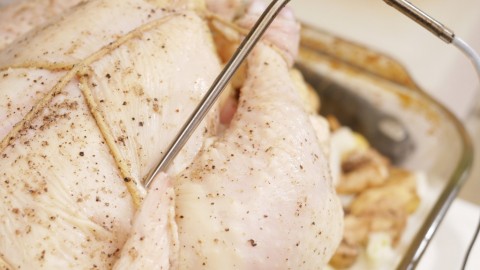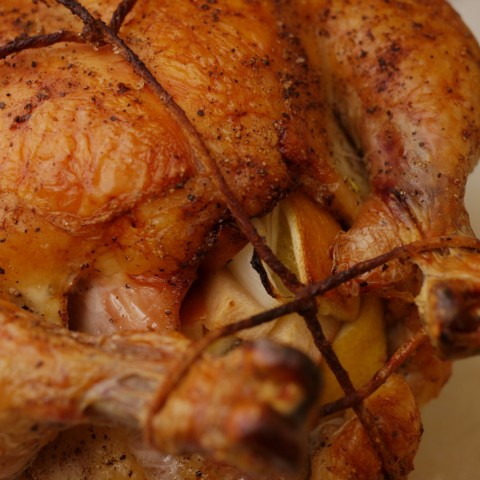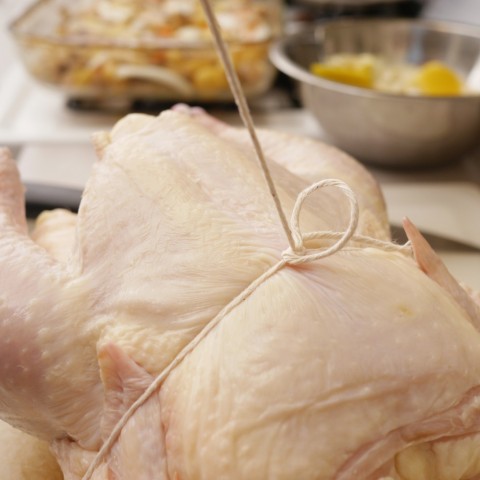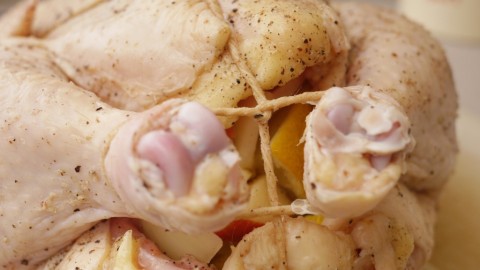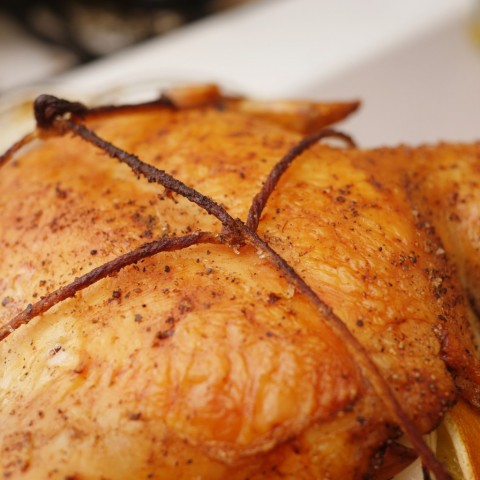So I’ve been looking back at the Twice Cooked archives, folks, and here’s a thing that really surprises me: given just how much chicken I cook — and specifically, given just how many whole chickens come through my house — I am shocked to find that the only thing I’ve ever written about roast chicken comes from way back in 2009, from the Livejournal carry-over prehistory of the blog.
This is a major oversight on my part. And today, I intend to remedy it.
I find, for some unknown reason, that lots of people consider the prospect of a roast chicken to be intimidating. Poking around on food forums, I am struck by the number of roast chicken posts that say something like: my family is coming for dinner on Thursday, and I have this whole bird and — OMFG *wimper* *wimper* *wimper* — I don’t know how to make it delicious and safe to eat! And I am even more struck by the number of posts that start out: my chicken is in the oven, and only now do I realize that I have no idea what to do!
The thing that’s so interesting about it is that of all the ways one could cook a bird — and a chicken especially — roasting it whole seems like it should be the simplest. Sealed box full of fire and hot air, plus bird, equals meal.
I fear that the trouble is that there is too much roast chicken advice out there; that the advice is piecemeal and sometimes contradictory; and that lots of it leaves folks with the impression that any kind of mistake will ruin the deliciousness of the bird, and possibly send one’s friends and family to the emergency room with a virulent poultry-borne dispepsia.
The first thing you’ll want to do to cook a great bird is calm down. Roast chicken is a wholesome dinner, not a salmonella factory with drumettes. There’s nothing easier than making a chicken safe and tasty. Just follow a few simple precepts and — and voilà.
So what I’ve come up with here is a short list of those precepts — in question and answer form. Read through them. Give the recipe a try. And in no time at all, you’ll be roasting birds like a pro.
How long should my roast chicken cook to make it safe?
According to the USDA, you should roast chicken until its internal temperature reaches about 165F.
There’s a lot of advice out there about what that means in minutes per pound, or about poking your chicken to see if the juices run clear, but I would recommend avoiding all forms of poultry prognostication. It’s not accurate. And if you err on the side of being safe and cook your chicken for too long, you’ll end up with something that’s dry, and leathery, and tough, and not at all pleasant to eat.
Instead, invest in a high-quality probe thermometer — ThermoWorks makes the best in my opinion. Jam the probe end into the deepest part of the chicken’s breast before it goes in the oven, and then never guess again.
The USDA might not be happy with me for saying it, but I would recommend removing your roast chicken from the oven when it reaches about 162F — not 165. As it rests, before you carve it, carryover cooking will take it well past the point of safe to eat.
At what temperature should I roast chicken?
This is actually kind of a controversial question, and there are basically three schools of thought: 1) the Emerils of the world are all about high heat — to really crisp that skin; 2) Heston Blumenthal, savant of The Fat Duck, says damn the skin — cook it at 200F for hours for maximum tenderness; and then 3) there’s the Daoist approach — balance in all things, roast chicken included.
Unsurprisingly, I fall into category number three. I would recommend preheating your oven to 350F, and letting your bird cook until the internal temperature reaches 120F. Then, turn the oven up to 450F and let the skin crisp as the chicken finishes roasting.
Lots of people say that I should brine my chicken. What’s that?
To brine, you soak your chicken in a solution of water, salt, and sugar (1 gallon, 1 cup, and 1/2 cup respectively) for somewhere between four and eight hours before you plan to cook it. The idea behind it is that the chicken will soak up the liquid and the seasoning, and therefore be more tender and more juicy and more flavorful when it gets to the table.
It’s a good idea, but not really worth it for most chickens. When you brine, what you’re doing is trading some of the intrinsic chickeny flavor of the bird for a little bit of extra moisture. And unless your chicken is of suspect quality, or unless you’re cooking a particularly large bird (big birds tend to be a bit drier when cooked), it’s a bad trade.
You may try it if you like. I have done it and enjoyed the results. But in most cases, I would recommend saving that brine for meat that needs it — like a turkey.
What about rubbing it under the skin with herbs and butter?
This I can get behind! I don’t usually do it, but when I have done it, it’s turned out great. Really, the thing you should consider as you’re planning your chicken is just how bad for you you want it to be. This will add significant fat content to a bird that’s already fairly rich. And if you’re okay with that — I say have a go!
And stuffing it? Some people do that, right?
Don’t stuff your bird. The problem with stuffing a roast chicken is that then you end up with a temperature problem. Instead of the deepest part of the breast having to get to 165F before it can come out of the oven, the deepest part of the stuffing has to get to that temperature. And by the time that happens, all will be left of your bird is a leathery shell.
Instead, I would recommend using that chicken cavity as a receptacle for a few twigs of fresh herbs, or a couple of pieces of lemon, or some garlic, or some prunes and sliced apples. If you don’t pack the cavity with too much stuff, and you don’t plan to eat its contents in the end, having some flavorings in there will add greatly to the deliciousness of your bird without detracting from its overall safety.
Then what do I do with all these [insert stuffing ingredients here]?
Cook them under the bird, of course! Thomas Keller, the dude who runs The French Laundry, highly recommends this. Instead of a bread stuffing or something like that, cut some up some vegetables — potatoes, turnips, and carrots are particularly good — and make a bed of them at the bottom of the roasting pan on which the chicken will sit. As it all cooks, the chicken juices will seep down into the vegetables, and you’ll end up not only with great chicken, but with a great side dish, too.
Also, this eliminates the need for a roasting rack. Which is a boon if, like me, you find them a terror to clean.
What’s your opinion on basting?
I am pro-basting. When I roast chicken, I tend not to start it off with any kind of liquid in the bottom of the pan. In part, this is for the sake of the vegetables already hanging out there. And in part, it’s because I rarely think of it.
But I do baste twice: about a half hour into the cooking, and then again just before I turn the temperature up to 450F, I will pour somewhere between a cup and a cup-and-a-half of liquid all over the chicken. This keeps it moist as it cooks, and it adds greatly to the flavor in the end.
You could baste just with chicken stock or just with water. But I would recommend going halfsies with chicken stock and madeira, marsala, sherry, or dry white wine. The combination adds a rich, sweet-savory flavor. And it does wonders for turning the skin a beautiful mahogany brown.
I’ve heard that some people stick a beer can up their chicken’s butt — or cook it upside down…
Don’t. Just — don’t.
Do I need to truss my roast chicken?
No, but it helps. Trussing your chicken, or binding it with twine, compacts the wings and legs into the body of the chicken, allowing it to roast more evenly and — in my opinion — making a much prettier presentation in the end.
To truss your chicken, start with about three feet of cooking twine. tie one end tightly around the wings. Then make a snug loop around the middle of the bird, just above the thighs, then make a third loop to hold the chicken’s legs and tail together — and tie it off.
It’s kind of tough to explain step by step, but it’s actually really simple to do. Have a look at the pictures. I’m pretty sure they’ll help.
How do I carve my roast chicken?
This is an expansive topic, and well beyond the scope of this Q&A. I imagine that I’ll do another post on carving at some point, but for now, know that there are lots of resources out there to teach you to do it. I would recommend having a look at this YouTube video as a place to start.
And how about that recipe?
Alright. Twist my arm.
1 Roasting Chicken, preferably from somewhere reputable
1-2 cups Chicken Stock, preferably homemade
1 cup White Wine (I like sauvignon blanc for the task)
3 Cloves of Garlic, crushed
1 Lemon, cut into quarters
Sprigs of fresh rosemary and thyme
3-4 cups Chopped Root Vegetables
Olive Oil
Pepper
Salt
Several hours ahead of time, remove the chicken from its packaging and leave it uncovered in the fridge. This will dry out the skin a bit and improve its ultimate crispness. Then, about an hour before you’re ready to cook, remove it from the refrigerator and allow it to come to room temperature.
Preheat your oven to 350F. Rub the chicken all over — inside and out — with salt, pepper, and olive oil. Add one or two slices of lemon, the garlic, and the herbs to the chicken’s cavity. Then truss it.
Oil the bottom of a roasting pan, and then add the root vegetables. Toss them with a little bit more salt, pepper, and olive oil. Position the chicken on top. Pop the probe of your thermometer in the deepest part of the breast, and then put the whole thing in the oven.
After half an hour, remove the chicken from the oven, baste it with about a cup of stock, plus a cup of white wine, and return it to its cooking. When it reaches 120F, baste it again and turn the oven up to 450F. When it reaches 162F, remove it from the oven.
Allow your chicken to rest for 20-30 minutes. This will allow its juices to reabsorb into the meat, making a better bird all around. While it is resting, you may remove the trussing and the contents of the cavity.
Then, when it is done, carve at the table and enjoy!
